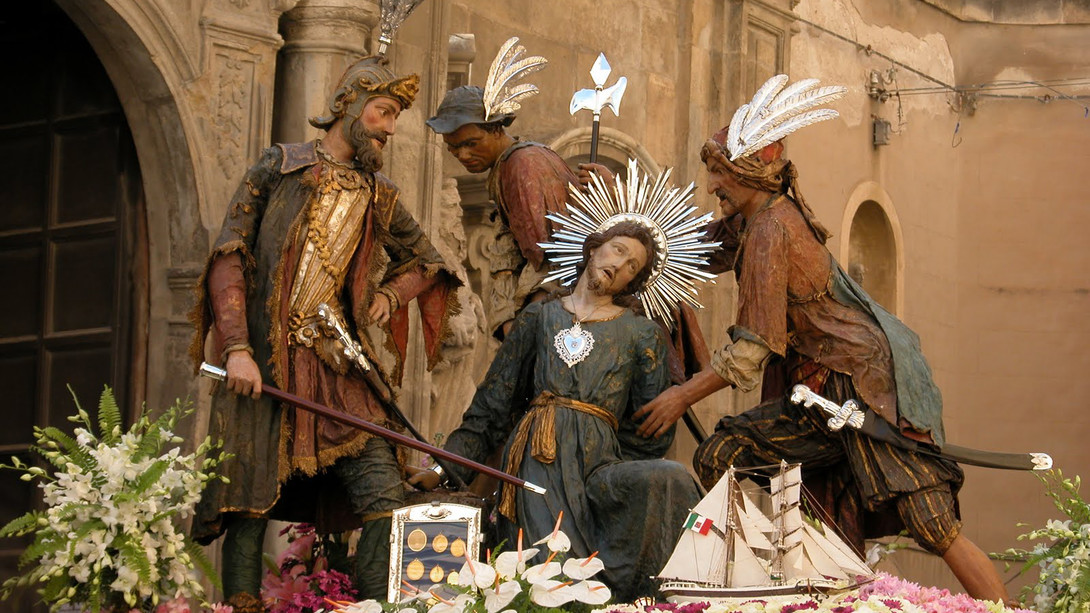
Easter: some events in Sicily
When in Rome, do as the Romans do: this saying is well suited to Sicily. In fact, depending on the area there are peculiar Easter traditions, celebrated through very folkloric events. Let’s look at some of them together.
The procession of the mysteries in Trapani
For more than 400 years in Trapani one can witness the ”Procession of the Mysteries.” Considered Italy’s longest religious event, it lasts for 24 hours from Friday to Saturday. This fits within the Holy Week processions, which have starts on Tuesday and run through Sunday.
The living paintings of Buseto Palizzolo
In opposition to the previous one, here is a very young tradition in the province of Trapani that has won everyone’s heart in just a few years. This is a procession in which the floats that pass through the streets on Easter Sunday are small stages depicting the Easter Mysteries. The event starts at 5 p.m. and goes on for about 6 hours.
U Nummu ru Jesus in Sortino
“The Name of Jesus” is a statue representing Christ at the Column fabricated in 1576. Tradition has it that it was miraculously found in the rubble of ancient Sortino razed to the ground by the 1693 earthquake and is now preserved in the side aisle of the church of St. Sophia.
Every year, at dawn on Good Friday, the statue is carried on the shoulders throughout the village in a procession. In detail, at 4 a.m. the ”sciuta” from the Church of Christ takes place, which, accompanied by songs and torches, is carried through narrow streets and alleys. Around 7 a.m., the statue is placed back in its place through the act known as ”oozing.”
The Sciaccariata of Ferla
The Sciaccariata of Ferla, a village in the province of Syracuse takes place on Holy Saturday. Shortly before midnight, the Risen Jesus is carried on the shoulders along the illuminated streets of the town center by numerous lit torches, known as “sciaccarre.” Hence the name of the celebration.
U Ballu di li Diavuli of Prizzi
“U Ballu di li Diavuli di Prizzi” is a spectacular festival that has made the small town of the same name in the province of Palermo very popular. The event begins in the early afternoon of Easter Sunday and sees the figure of death, dressed in a yellow jumpsuit and a skull mask, roaming the streets accompanied by devils, obviously in red jumpsuits. All accompanied by singing, dancing and jokes. The climax occurs in Barone Square when the Risen Christ and Our Lady meet and a dispute between angels and devils happens, with good triumphing.
Byzantine Easter in Piana degli Albanesi
Easter rituals in this area are very old and equally related to the original ethnicity. The liturgical celebrations of the Pashkët are in the Greek language and, among the many events, a few more significant ones stand out. For example, the washing of the feet (Holy Thursday), the Resurrection of Lazarus (Good Friday). But also, celebrations with Albanian funeral songs and the use of wooden instruments of Byzantine origin. And the procession of women dressed in 15th-century Albanian dresses for Easter Sunday.
The procession of the hooded men of Enna
The procession of the hooded men of Enna is staged on Good Friday, when about three thousand confreres, wearing loose tunics and white hoods, parade in a funeral ritual of accompanying the fercules of Christ and the Madonna to the sound of folk songs and funeral marches.
Barettas and the Feast of the Jew of Messina
The“Barette” tradition dates back to 1610, to the time of Spanish rule. Its name comes from the original Way of the Cross in which an image of Our Lady of Sorrows and a simulacrum of a coffin with Christ were carried on the shoulders. Today it consists of about 11 statuary groups depicting the Passion of Christ.
Instead, the Feast of the Jew culminates on Holy Wednesday, Thursday, and Friday, when the villagers don the robes of the Jew and, wearing red muslin jackets and breeches, walk the streets of the village. The purpose is to remember the figure of the scourger who lashed out at Jesus.
The Procession of the Royal Maestranza of Caltanissetta.
This very special rite takes place on Holy Wednesday and owes its origins to 1551, when a city militia was created against the Turkish siege. This ”Real Maestranza ” was made up of artisans and led by a captain of arms, usually a nobleman. Each year a different Captain is chosen and this one enjoys certain privileges during Holy Week, including having the Keys of the city of Caltanissetta, the sword, the tricolor sash and being appointed Knight of the Republic.
The Madonna vasa-vasa of Modica
“Vasa” in Sicilian means “kiss.” This Modican tradition is celebrated during Easter Sunday and culminates with the “midday kiss,” at 12 noon precisely, between Our Lady and the Risen Christ.
These are just some of the celebrations that take place in our region during the Easter season. One by one, all to be discovered!
Top photo by: tp24.co.uk





